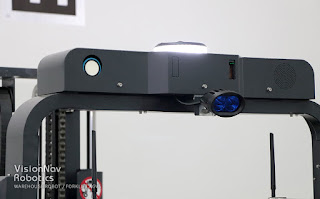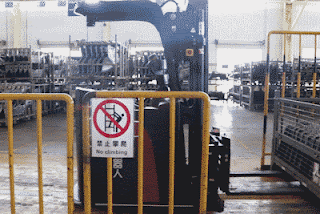In the new era of unmanned logistics, warehousing becomes initial
strategic point
Unmanned technology has become a heated topic in logistics industry since
the beginning of the year 2020. The epidemic
outbreak hits existing industries real hard, but also brings some opportunities
–the restarting driverless vehicles are setting off another wave of robots
replacing human. With expedited release of market demands and the support of
technology and capital, unmanned logistics will enter a new era.
Looking from its overall structure, a logistics system can be viewed
as a crisscrossed network, the connected nodes are logistics centers,
enterprise warehouses and regional distribution points, and the interlaced
lines are transportation services such as trunk transportation, branch transportation,
and last-mile delivery. While road transportation using self-driving cars is
still in the attempt, the technology of automatic warehousing seems to be more
mature and is gradually becoming a strategic move in unmanned logistics.
 |
| Unmanned Logistics Full View |
Forklift AGV has great potential with increasing needs of unmanned
transportation inside the warehouse
Driven by market demands, technology development and other multiple
factors, the unmanned process to replace traditional warehouse system has been accelerated.
Automatic equipment inside a warehouse mainly include automatic sorting robots,
wearable devices, cargo identification devices and forklift AGVs. While automatic
sorting technology is still developing, cargo identification techniques are
work-in-process, the most mature forklift AGVs with high cost-effective are much
more popular.
According to the data released by CITA, the total sales volume of
industrial vehicles in China are more than 600,000 units in 2019, indicating 2%
increase compared to the previous year. Thereinto, about 298,600 units are
forklifts in indoor warehouses, which makes up 43% of the total number. In
addition, there is a growing trend for forklift in recent years. With the
gradual deepening of “robots replacing human”, demands for forklift AGVs will
be more and more obvious indicating a huge market potential.
 |
| 2019 Industrial Vehicles Total Sales Volume in China |
Complicated Intensive Storage Scenarios Are What Forklift AGVs
Needs to Overcome
When it comes to operations inside the warehouse, there are mainly 2
scenarios for forklift AGVs to replace manual forklifts: 1. truck loading, different
trucks such as cube, wing opening, flatbed, etc., in the environment of loading
platform, factory/ in-house or container yard; 2. Intensive storage scenarios,
including drive-in racks, beam type racks, narrow aisle racks, double deep
racks, shuttle racks, stack racks and other pallet racking. With the deepening
of automation integration and unmanned conditions getting mature, indoor
intensive storage become the main scenarios to use Forklift AGVs.
 |
| 6 Types of Racking in Intensive Storage |
“Space utilization of intensive storage for middle or high level racking is relatively high, making it one of the major storage types at present. Besides, complicated working condition of intensive storage scenarios raises higher requirement for forklift AGV at the same time.” said Dr. Li Luyang, CEO of VisionNav Robotics, one of the representative enterprises for visual driverless industrial vehicles in China. These requirements mainly are:
1) Higher accuracy: considering
task completion and safety in the warehouse operations, there are higher
requirements for forklift AGV in terms of positioning accuracy and operation
accuracy.
2) High flexibility: forklift
AGVs need to improve the flexibility and self-adaptability in order to cope
with non-standardized manual operations, changes of different carriers, changes
of operating space, etc.
3) High efficiency: as the
entire logistics industry is speeding up, the advantage of forklift AGVs
replacing manual forklifts is mainly lies in its efficiency.
4) Safety protection: the
overall protection is not only to identify and avoid obstacles during the
driving, but also to consider risks in high position and high-level racks
operations, for example for safer technology is required for drive-in racks,
narrow aisle racks, moveable stack racks, etc., to protect human, vehicles and goods.
With vision techniques, forklift AGVs can be widely applied in
intensive storage scenarios
To solve
current problems faced by forklift AGVs in the intensive storage scenarios, we
must highly rely on in-depth researches and innovations. When talking about industry development, Mr. Chen Baoqiang, deputy
director of the National Engineering Quality Supervision and Inspection Center,
emphasized the importance of in-depth technology innovations. “Lack of
innovation means lack of driving force for industry progress. There will be no
innovation without in-depth research.”
Dr. Li Luyang also said during an
interview with the reporter from XZL Robot Full-media, that the urgent tasks
for forklift AGVs is to improve their level of intelligence. “You can simply
view it as the robot ability to deal with non-standardized situations onsite,
which is definitely based on the understanding and learning of the environment.
Therefore vision technology is now the only way to improve forklift AGV
intelligence, which is also what VisionNav Robotics has been working on for the
past 3 years since the establishment.”
 |
| Vision Navigation Forklift AGVs for High Position from VisionNav Robotics |
Visual sensors is also one
of the heated topics in the fields of unmanned forklift researches. Compared to
traditional laser sensors, visual sensors have stronger abilities of
information acquisition, and better systematic expandability: (1) there are 5 million points of information in a 5-megapixel
photo, and if 10 photos are acquired and processed in a second, it is equivalent
to acquiring 50 million points of information; (2) the points in the photo contain
more information than laser such as colors and patterns, providing a large
amount of valuable information for positioning, control and environmental
perception; (3) the perfect combination of vision and 5G in the future enable
us to transmit image information to the cloud through high speed network for
edge computing, or transmit to the serve for parallel computing, further
improving the performance of vision navigation by a large margin.”
It is learned that VisionNav Robotics has been working deeply in the
fields of vision navigation technology. With its unique techniques, rapid
growth and strong explosive ability, VisionNav Robotics is the first company to
complete reach truck unmanned modification and application for high level
operation. They also overcome the challenges of stacking racks up to 4 levels
precisely, which is one of the most difficult operations in the fields. Such stacking
techniques have already been practically applied in an automatic warehouse of an
auto parts manufacturer giant in South China. For the past 3 years, vision navigation forklift AGVs developed by
VisionNav Robotics have been accumulated applied in over 150 complicated
scenarios, including automatically picking and placing cargos from/to middle
and high levels in domestic intensive warehouses of many leading enterprises in
logistics, bonded, FMCG and other industries.
Application
1: Vision Navigation Forklift AGVs from VisionNav Robotics and its Application
of Stacking Racks
Difficulties: stacking 30 different types of stack
racks with wheels in random positions is a great challenge for forklift AGVs in
terms of intelligence level and operational accuracy.
Application
2: Vision Navigation Forklift AGVs from VisionNav Robotics and its Application
in High Level Beam Type Racks
Difficulties: compared to horizontal transportation, picking
and placing cargo from/to high positions requires further detection of the
storage locations, and such detection takes more time, therefore forklift AGVs
should make a perfect balance among efficiency, accuracy, intelligence level
and safety.
Application
3: Vision Navigation Forklift AGVs from VisionNav Robotics and its Application
in Drive-in Racks
Difficulties: there is limited space in the drive-in
racks, therefore the positioning accuracy and operational accuracy requirement
for forklift AGVs is the highest among all types of racks; in addition, moving
pallets like playing Klotski while keeping up with transportation tempo at the
same time is also a big challenge for forklift AGV operation efficiency.
It is reported that VisionNav Robotics will further focus on the
common requirements and pain points of forklift AGVs, developing applications
for outdoor truck loading, improving application range and depth of driverless
industrial vehicles, and providing highly effective solutions to more and more enterprises.























